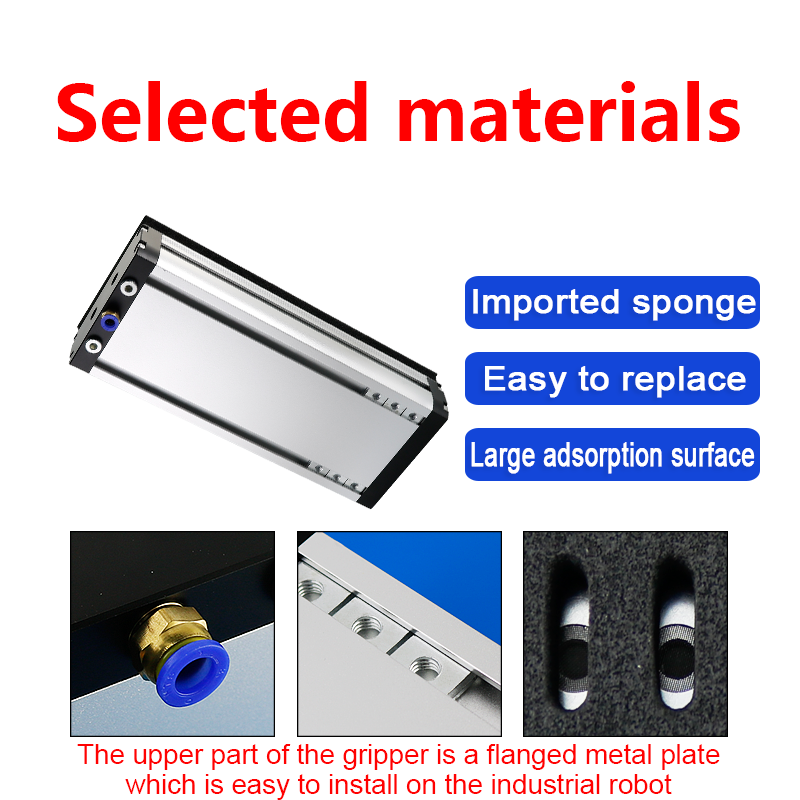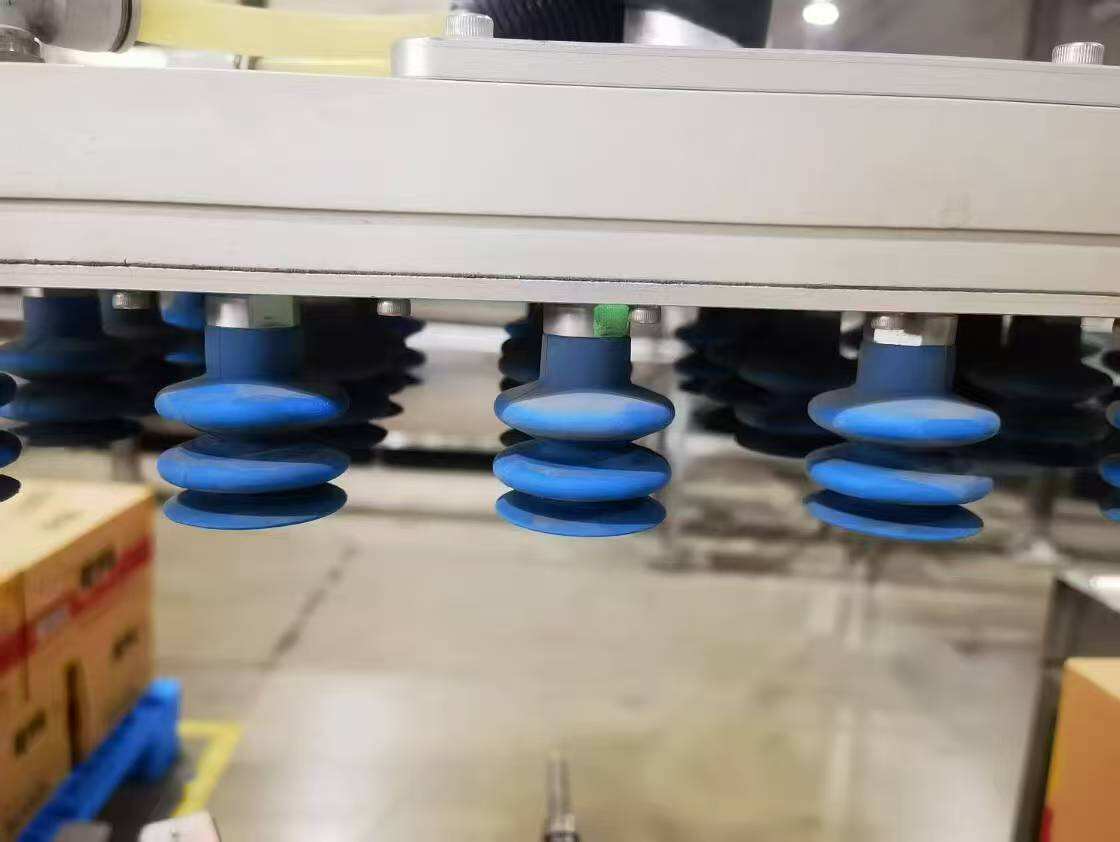Ինչպես 130-շարքի ինտեգրված վակուումային ծծող փողերը փոխակերպում են արկղերի, պողպատի և փայտի համար ռոբոտի կեղծվածքը
Time: 2025-08-28
Արտադրողների և տրանսպորտային թիմերի համար, ովքեր հենվում են ծանր ռոբոտական բազկերի վրա, անարդյունավետ ծծող գործիքները հաճախ նշանակում են մեկ բան՝ կորցրած ժամանակ և գումար: Վակուումային համակարգերի արտահոսքը դանդաղեցնում է պալետավորումը, կոշտ փողերը աղավաղում են արժեքավոր բեռները, իսկ «մեկ չափը բոլորի համար» դիզայները ձախողվում են բռնել տարբեր նյութեր, ինչպիսիք են տուփերը, պողպատե թիթեղները և փյունիկե տախտակները:

Մեր նոր 130-սերիայի ինտեգրված վակուումային սիլիկոնե ծծաններ ստեղծվել են հենց այդ խնդիրները լուծելու համար: Շնորհիվ ներդրված վակուումային համակարգի, մեղմ, սակայն դիմացկուն սիլիկոնե բռնակների և բարձր հզորության ռոբոտային բազկերի հետ համատեղելիության, դրանք «անվստահելի կերպով կատարվող բեռնաթափումը» վերածում են «հարթ, առանց ամբարձիչի վնասվածքների բեռնաթափման»: Ստորև ներկայացված են երեք իրական դեպքեր լոգիստիկայից, մետաղամշակման և ապարանքների արտադրությունից՝ ցույց տալով, թե ինչպես է 130-րդ սերիան ապահովում չափելի արդյունքներ:
Դեպք 1. E-առևտրային տրանսպորտային ոլորտ՝ 35% ավելի արագ տուփերի պալետավորում առանց աղեղների
Եղանակը
FastMove Logistics, եվրոպական էլեկտրոնային առևտրի կազմակերպում, դիմակայում էր ռոբոտիզացված բազկերի տուփերի բեռնաթափման գործողություններին.
- Ավանդական ծծող գործիքները պահանջում էին ծավալուն արտաքին փոշետունկիչ պոմպեր, որոնք 45 րոպե էին ծախսվում մեկ բազկի համար և հաճախ արտաթորում էին փոշին բռնելիս փքված կամ կորուգացված տուփերը:
- Դանդաղ պլաստմասսայե փողերը աղեղներ էին թողնում տուփերի 7%-ի վրա (որի պատճառով շաբաթական կորուստը կազմում էր €1,800) և չէին հարմարվում տարբեր չափերի տուփերին (300x400 մմ-ից մինչև 600x800 մմ):
- Վերաբերմունքի սեզոնների ընթացքում (Սև ուրբաթ, Ծնունդ), վակուումային համակարգի անջատումները ամենօրյա պալետային հզորությունը կրճատեցին 20%-ով։
Լուծում. 130-շարքի ինտեգրված վակուումային սիլիկոնե ծծակներ
FastMove-ը 130-շարքի ծծակները տեղադրեց իր 8 ծանր ռոբոտական բազկերի վրա՝ օգտագործելով երկու հիմնարար առավելություններ.
- Տեղական վակուումային համակարգ : Վերացրել է արտաքին պոմպերի և խողովակների կարիքը: 130-րդ սերիան ստեղծում է հաստատուն վակուումային ճնշում (-90 կՊա) 0,3 վարկյանում, կրճատելով մեկ բազկի կարգավորման ժամանակը 45 րոպեից մինչև 10 րոպե և վերացնելով արտահոսքի հետ կապված կանգերը:
- Մեղմ սիլիկոնե բռնում ՝ Սննդային աստիճանի սիլիկոնե ծծակները համապատասխանում են փքված տուփերի եզրերին և նուրբ փաթեթավորմանը՝ կանխելով արատները: Ծծակների 130 մմ տրամագիծը նաև թույլ է տալիս տեղավորել տարբեր չափերի տուփեր առանց կարգավորումների։
Արդյունքը
- Բեկանքի մնացորդային մակարդակը նվազեց 7%-ից մինչև 0.2% (խնայողություն՝ 1764 եվրո/շաբաթ)։
- Պալետավորման արդյունավետությունը մեծացավ 35%-ով՝ ամենօրյա մշակելով 1200 ավելի շատ տուփեր սեզոնային շրջանների ընթացքում։
- Վակուումային համակարգերի սպասարկման ժամանակը նվազել է 80%-ով (շաբաթական 12 ժամից մինչև 2,4 ժամ), թույլատվելով թիմերին կենտրոնանալ պատվերների կատարման վրա։
«Մենք նախ թիմ ունեինք, որը վակուումային պոմպների արտահոսքերն էր վերացնում», ասել է ՖասթՄուվի գործառնական տնօրեն Մարկո Քլայնը։ «130-շարքը այդ խնդիրը լուծելի է դարձրել՝ մեր ռոբոտները այժմ համակարգված են աշխատում սկզբից մինչև վերջ։»

Երկրորդ դեպք. մետաղական կոնստրուկցիաներ – Առանց անկման և վնասվածքների կոշտ պողպատե սալերի տեղափոխում
Եղանակը
ՍթիլԿոն, որը հյուսիսամերիկյան մետաղական կոնստրուկցիաների արտադրող է, հիմնված էր ռոբոտային բազկերի վրա՝ տեղափոխելու 3-8 մմ հաստությամբ պողպատե սալեր (500x700 մմ-ից մինչև 800x1000 մմ), սակայն առեր կրիտիկական խնդիրներ.
- Արտաքին վակուումային ֆիլտրները ամեն 2 օրը մետաղական փոշիով խցանվում էին, որի արդյունքում հաճախադեպ փոխարկման կարիք էր առաջանում և առաջացնում էր բեռնաթափումների 15%-ի ձախողում (որի արդյունքում շաբաթական վերամշակման ծախսերը կազմում էին 2200 դոլար)։
- Կոշտ և մետաղապատ մակերեսների վրա ամուր միացման կարողություն չունեցող վակուումային փողերը ստիպում էին օպերատորներին բեռնատարությունը 40%-ով նվազեցնել անկումներից խուսափելու համար։
- Պողպատե թիթեղների մետաղական հրացանները վնասեցին արտադրանքի 5%-ը, ինչը հանգեցրեց հաճախորդների կողմից վերադարձի
Լուծումը՝ 130-շարքի ինտեգրված վակուումային փողեր
SteelCo-ն իր ռոբոտային բազկերի շարքի մեջ ներառեց 130-շարքի փողեր, կենտրոնանալով արդյունաբերական դասի նախագծման վրա.
- Շինված վակուումային համակարգ ինքնամաքրման ֆիլտրով 130-շարքի 5մկմ լվացվող ֆիլտրը թույլ չի տալիս մետաղական փոշին և հրացանները անցնել, ինչի արդյունքում ֆիլտրի կյանքը երկարացվում է մինչև 4 շաբաթ (նախկինում 2 օր արտաքին ֆիլտրների դեպքում): Ֆիլտրների փոխարկման համար անպլան կանգերը այլևս խնդիր չեն հանդիսանում:
- Դիմացկուն սիլիկոն + ամուր բռնում սիլիկոնե փողի տեքստուրային մակերեսը ապահովում է խցանման հարթություն կոպտատ պողպատի վրա, պահպանելով լիարժեք բեռնվածությունը (մինչև 50 կգ փողի հաշվով) առանց արտահոսքի: Մեղմ սիլիկոնը նաև կանխում է մետաղի վրա մետաղի արտաքին վնասվածքները:
Արդյունքը
- Բեռնման անհաջողության դեպքերի քանակը նվազեց 15%-ից մինչև 0.8%, ինչի շնորհիվ տեղի ունեցավ շրջանային ծախսերի կրճատում՝ 2004 ԱՄՆ դոլար/շաբաթ
- Պողպատե թիթեղների մշակման հզորությունը ավելացավ 40%-ով՝ այժմ մեկ ժամում մշակվում է 80 լիարժեք թիթեղ, որը նախկինում 57 էր
- Ծանր վերադարձի մակարդակը սառը ցուրտ պողպատե ապրանքների համար ընկավ մինչև 0%, իսկ հաճախորդների բավարարվածության ցուցանիշները բարելավվեցին 28%-ով։
«Քարացած պողպատը մեր ռոբոտիզացված բազկերի ամենամեծ թշնամին էր», ասաց Սառա Չենը՝ SteelCo-ի սպասարկման պատասխանատուն։ «130-շարքի ներդրված համակարգը և սիլիկոնե բռնումը այդ «խնդրային սալերը» վերածեցին մեր ամենաարդյունավետ վերուվահանումների»։
Ուսումնասիրություն 3. Կահույքի արտադրություն՝ առանց ամբարձում փայտե տախտակների վրա ամբարձում փոխանցող մակերեսների համար
Եղանակը
WoodCraft-ը, որը Ասիայի ամենամեծ կահույքի արտադրողն է, պետք է ավտոմատացներ փայտե տախտակների վերուվահանումը (20-30 մմ հաստությամբ, փայտաշեղեր և աղեղավոր կաղնիներ), սակայն հանդիպեց մի շարք խոչընդոտների.
- Ավանդական ծծող փողերը թողնում էին շրջանաձև հետքեր փայտե տախտակների 9%-ի վրա, ինչը պահանջում էր ձեռքով շփում (ավելացնելով 2 ժամ/տեղաշարժ արտադրության ընթացքում)։
- Արտաքին վակուումային խողովակները բռնվում էին ռոբոտիզացված բազկերի շարժումների մեջ, ինչի արդյունքում վերուվահանումների 10%-ը չեղարկվում էր, իսկ տախտակների 3%-ը վնասվում էր։
- Ընկերության մեծ ծանրության ռոբոտային բազկերին (բեռնատարություն 60 կգ+) անհրաժեշտ էր մշակել մի միջոց, որը կարող է կառավարել 35 կգ կշռող փայտե տախտակներ առանց գրիպի կամ մակերեսի որակի վատացման
Լուծումը՝ 130-շարքի ինտեգրված ռոբոտային վակուումային սիլիկոնե միջոցներ
WoodCraft-ը 130-շարքի միջոցները կիրառեց իր 6 ռոբոտային բազկերի վրա՝ օգտագործելով արտադրանքի հատուկ նախագծումը նուրբ, սակայն ծանր բեռների համար.
- Առանց արահետ թողնող սիլիկոնե միջոցներ ՝ 130-շարքի ցածր կպչուն սիլիկոնե նյութը բարձրացնում է փայտե տախտակները առանց արահետ թողնելու, որի արդյունքում վերացվում է մշակումից հետո փշրանքի կարիքը
- Ինտեգրված, կոմպակտ դիզայն ՝ Արտաքին խողովակների կամ պոմպերի բացակայությունը նշանակում է ճոճվող մասերի բացակայություն՝ ռոբոտային բազկերը ազատ շարժվում են, իսկ չեղարկված բարձրացումները նվազում են 10%-ից մինչև 0.5%: միջոցների 130 մմ տրամագիծը ճնշումը հավասարաչափ է բաշխում, թույլ տալով հեշտությամբ կառավարել 35 կգ տախտակները
Արդյունքը
- Փայտե տախտակների արահետների մակարդակը նվազեց 9%-ից մինչև 0.3%, ինչը փշրանքի ժամանակը կրճատեց 2 ժամ/հերթափոխով (ամսական խնայում՝ 48 ժամ)
- Չեղարկված բարձրացումները նվազեցին 10%-ից մինչև 0.5%, ինչի արդյունքում փայտե տախտակների վնասվածքները նվազեցին 83%-ով
- Արտադրությունը ավելացել է 18%-ով՝ այժմ ամսական ավարտվում է 120 հատ ավելի շատ կահույք
«Մենք կարծում էինք, որ պետք է ընտրենք «հզոր բռնում» և «նուրբ կերպով վերցնել» տարբերակներից», ասաց ՎուդՔրաֆթի արտադրության տնօրեն Ռաջիվ Մեհտան: «130-րդ սերիան մեզ տալիս է երկուսն էլ՝ մեր ռոբոտային բազկերը այժմ փայտը մշակում են ինչպես մարդիկ, բայց ավելի արագ»
Ինչու է 130-րդ սերիան աշխատում տարբեր արդյունաբերություններում
130-րդ սերիայի ինտեգրված վակուումային սիլիկոնե փողերը առանձնանում են իրենց հնարավորությամբ հարմարվել տարբեր նյութերի և մակերեսների հետ.
- Տեղական վակուումային համակարգ կրճատում է սարքավորման ժամանակը, վերացնում է արտահոսքը և պահպանում է սպասարկումը՝ կարևոր բարձր ծավալով աշխատող գործողությունների համար, ինչպես օրինակ տրանսպորտային և մետաղական արտադրությունը
- Սիլիկոնական ցանցերը ապահովում է առանց արատների բռնում նուրբ բեռերի համար (տուփեր, փայտի փայլ), միևնույն ժամանակ ամուր բռնում է կոպտատեսք մակերեսները (պողպատ, չփայլակված փայտ)
- Ամրակայում է ծանր սարքավորումների հետ աշխատում է բարձր հզորությամբ ռոբոտային բազկերի հետ (բեռնատարողականություն 50 կգ-ից ավելի)՝ բեռեր մինչև 50 կգ-ը բարձրացնելու համար՝ արդյունաբերական չափերի համար իդեալական է
Անկախ նրանից՝ արդյոք դուք փաթեթավորում եք տուփեր, տեղափոխում եք պողպատե սալեր, թե փայտե տախտակներով աշխատում, 130-րդ սերիան ռոբոտի կառավարումը վերածում է մրցակցային առավելության:

Տեսեք 130-Սերիան գործողության մեջ
Ցանկանու՞մ եք ձեր ռոբոտի բազկերի և բեռների հետ ստանալ նույն արդյունքները: Խնդրեք անվճար ցուցադրում վայրում. մեր թիմը ձեր տուփերի, պողպատե սալերի կամ փայտե տախտակների հետ կփորձարկի 130-րդ սերիան և կտրամադրի արդյունավետության հատուկ զեկույց, որտեղ ցուցադրված կլինի, թե ինչքան կարող եք խնայել կանգառների, թափոնների և աշխատանքի ժամանակ:
👉 Պահանջել անվճար ռոբոտի բազկի ցուցադրում
👉 Ներբեռնել 130-Սերիայի տեխնիկական տվյալների թերթիկը
👉 Տեսնել տեսանյութը՝ 130-րդ սերիան բարձրացնում է պողպատե սալեր և տուփեր
👉 Ներբեռնել 130-Սերիայի տեխնիկական տվյալների թերթիկը
👉 Տեսնել տեսանյութը՝ 130-րդ սերիան բարձրացնում է պողպատե սալեր և տուփեր
«130-րդ սերիան միայն բարելավեց մեր ռոբոտի կառավարումը, այլ նաև վերափոխեց մեր ամբողջ գործընթացը», ասաց հաճախորդներից մեկը: «Այդ է տարբերությունը գործիքի և լուծման միջև»:

